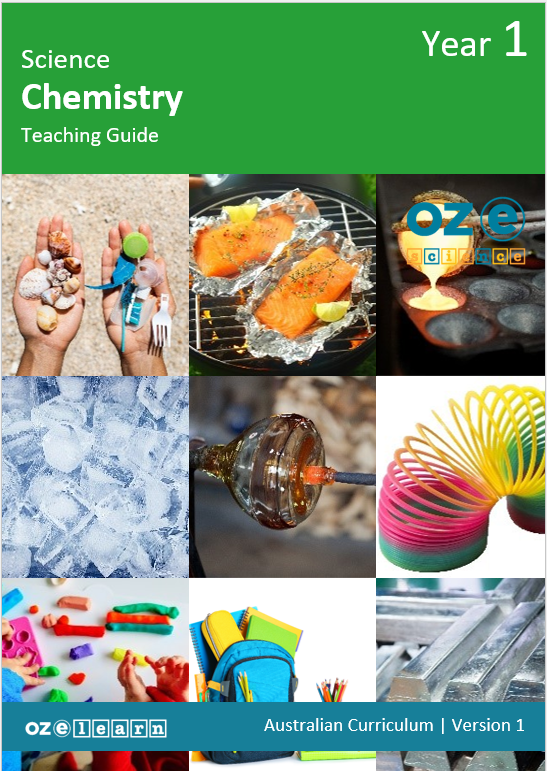Oz-e-science

In Lessons 1 to 9, students learn about:
- materials that they use every day
- sorting everyday objects by what they are made of
- materials that can bend
- making a model caterpillar using the bendable material of metal
- experimenting with a material to learn about stretching
- materials that can be stretched
- materials that can be cut and/or crushed
- experimenting with materials that can be crushed
- how materials change when they are heated.
- experimenting with heating a material
- what happens when wax is cooled
- what happens to materials when cooled
- how Indigenous Australians used heating and cooling to physically change a material
- describing the ways Indigenous Australians physically changed materials
- representing an animal that will be made from air dry clay and labelling it with the methods used to physically change the air-dry clay
- how to represent a chosen animal by making it out air-dry clay using stretching, twisting, cutting, bending and crushing to create it
- communicating to the class the methods used to create the animal.
- Find what materials everyday objects are made from.
- Sort everyday objects by what they are made of.
- Look at materials that can be changed by bending.
- Make a model of a caterpillar using the bendable material of metal.
- Experiments with stretching various materials.
- Measure the length of each of the materials once it has been stretched.
- Find materials that stretch.
- Look at materials that can be cut and/or crushed.
- Experiment crushing a range of materials.
- Look at how materials change when they are heated.
- Experiment by heating a material.
- Observe what happens when water is cooled.
- Predict what happens to various materials when they are cooled.
- Identify how Indigenous Australians used heating and cooling to physically change a material.
- Describe ways Indigenous Australians physically change materials.
- Design and represent and animal that will be made from air dry clay.
- Label the drawing with the ways they will physically change the air-dry clay to create the animal.
- Physically change the air-dry clay to create their animal by bending, stretching, twisting, cutting and crushing.
- Communicate the methods used to physically change the air-dry clay to create the animal.
Progress Tests
Progress tests are conducted after every second lesson, allowing teachers to monitor student understanding of the concepts taught over the past two lessons and to identify where reteaching is needed. The Teaching Guide contains the testing questions, and the Student Workbook has a section where students write their answers and score themselves.
Structured Research Activity
The Structured Research Activity (SRA) for this unit is: Students design and make an air-dry clay animal, experiment on the animal and report results. The SRA takes place over two lessons so students can apply the Science Understanding and Science Inquiry Skills covered in the unit. Teachers use the Guide to Making Judgements, which is included in the Teaching Guide, to mark the SRA.
End-of-Unit Assessment
The last lesson is the end-of-unit assessment, which has a variety of question formats (e.g. label the diagram, circle the correct answer) to assess student mastery of content from the unit. The end-of-unit assessment is in the Teaching Guide. Teachers copy the assessment and distribute to students at testing time.
Progress tests are conducted after every second lesson, allowing teachers to monitor student understanding of the concepts taught over the past two lessons and to identify where reteaching is needed. The Teaching Guide contains the testing questions, and the Student Workbook has a section where students write their answers and score themselves.
Structured Research Activity
The Structured Research Activity (SRA) for this unit is: Students design and make an air-dry clay animal, experiment on the animal and report results. The SRA takes place over two lessons so students can apply the Science Understanding and Science Inquiry Skills covered in the unit. Teachers use the Guide to Making Judgements, which is included in the Teaching Guide, to mark the SRA.
End-of-Unit Assessment
The last lesson is the end-of-unit assessment, which has a variety of question formats (e.g. label the diagram, circle the correct answer) to assess student mastery of content from the unit. The end-of-unit assessment is in the Teaching Guide. Teachers copy the assessment and distribute to students at testing time.
Oz-e-science applies a teaching approach and curriculum that uses explicit teaching of content and knowledge of science as well as explicit teaching and practical scientific inquiry using the Scientific Method. Read more about pedagogy here.

